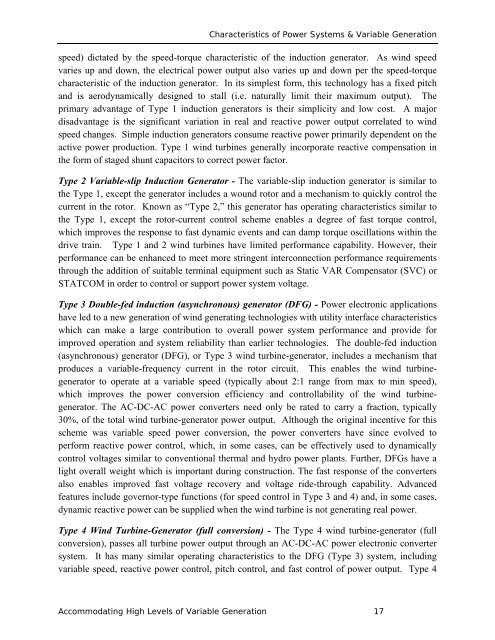Accommodating High Levels of Variable Generation - NERC
Accommodating High Levels of Variable Generation - NERC
Accommodating High Levels of Variable Generation - NERC
Create successful ePaper yourself
Turn your PDF publications into a flip-book with our unique Google optimized e-Paper software.
Characteristics <strong>of</strong> Power Systems & <strong>Variable</strong> <strong>Generation</strong><br />
speed) dictated by the speed-torque characteristic <strong>of</strong> the induction generator. As wind speed<br />
varies up and down, the electrical power output also varies up and down per the speed-torque<br />
characteristic <strong>of</strong> the induction generator. In its simplest form, this technology has a fixed pitch<br />
and is aerodynamically designed to stall (i.e. naturally limit their maximum output). The<br />
primary advantage <strong>of</strong> Type 1 induction generators is their simplicity and low cost. A major<br />
disadvantage is the significant variation in real and reactive power output correlated to wind<br />
speed changes. Simple induction generators consume reactive power primarily dependent on the<br />
active power production. Type 1 wind turbines generally incorporate reactive compensation in<br />
the form <strong>of</strong> staged shunt capacitors to correct power factor.<br />
Type 2 <strong>Variable</strong>-slip Induction Generator - The variable-slip induction generator is similar to<br />
the Type 1, except the generator includes a wound rotor and a mechanism to quickly control the<br />
current in the rotor. Known as “Type 2,” this generator has operating characteristics similar to<br />
the Type 1, except the rotor-current control scheme enables a degree <strong>of</strong> fast torque control,<br />
which improves the response to fast dynamic events and can damp torque oscillations within the<br />
drive train. Type 1 and 2 wind turbines have limited performance capability. However, their<br />
performance can be enhanced to meet more stringent interconnection performance requirements<br />
through the addition <strong>of</strong> suitable terminal equipment such as Static VAR Compensator (SVC) or<br />
STATCOM in order to control or support power system voltage.<br />
Type 3 Double-fed induction (asynchronous) generator (DFG) - Power electronic applications<br />
have led to a new generation <strong>of</strong> wind generating technologies with utility interface characteristics<br />
which can make a large contribution to overall power system performance and provide for<br />
improved operation and system reliability than earlier technologies. The double-fed induction<br />
(asynchronous) generator (DFG), or Type 3 wind turbine-generator, includes a mechanism that<br />
produces a variable-frequency current in the rotor circuit. This enables the wind turbinegenerator<br />
to operate at a variable speed (typically about 2:1 range from max to min speed),<br />
which improves the power conversion efficiency and controllability <strong>of</strong> the wind turbinegenerator.<br />
The AC-DC-AC power converters need only be rated to carry a fraction, typically<br />
30%, <strong>of</strong> the total wind turbine-generator power output. Although the original incentive for this<br />
scheme was variable speed power conversion, the power converters have since evolved to<br />
perform reactive power control, which, in some cases, can be effectively used to dynamically<br />
control voltages similar to conventional thermal and hydro power plants. Further, DFGs have a<br />
light overall weight which is important during construction. The fast response <strong>of</strong> the converters<br />
also enables improved fast voltage recovery and voltage ride-through capability. Advanced<br />
features include governor-type functions (for speed control in Type 3 and 4) and, in some cases,<br />
dynamic reactive power can be supplied when the wind turbine is not generating real power.<br />
Type 4 Wind Turbine-Generator (full conversion) - The Type 4 wind turbine-generator (full<br />
conversion), passes all turbine power output through an AC-DC-AC power electronic converter<br />
system. It has many similar operating characteristics to the DFG (Type 3) system, including<br />
variable speed, reactive power control, pitch control, and fast control <strong>of</strong> power output. Type 4<br />
<strong>Accommodating</strong> <strong>High</strong> <strong>Levels</strong> <strong>of</strong> <strong>Variable</strong> <strong>Generation</strong> 17
















